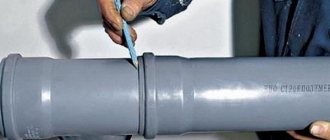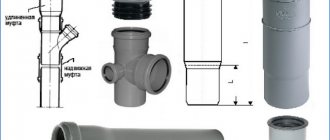A sewer riser is a vertical pipe in the bathroom where waste from plumbing fixtures from around the house flows. As a rule, the bathroom, toilet and kitchen in apartments are located nearby, which makes it possible to create a common sewer line for all plumbing. In this case, the sewerage system in a multi-story building has a minimum length, which is significant for a gravity sewer system. If there are problems with waste drainage, in 90% of cases this is due to a malfunction of the riser.
Regulations
Russian legislation has a clear procedure for replacing risers and other parts of the sewer system.
The procedure is regulated by the following documents :
- GOST R 56534-2015;
- “Rules for the maintenance of common property in apartment buildings” , approved by Decree of the Government of the Russian Federation No. 491 of August 13, 2006;
- “Rules and standards for the technical operation of housing stock” , approved by Order of the State Construction Committee of the Russian Federation No. 17-139 of December 25, 1998;
- Methodological manual MDK 2-04-2004.
Read in this article who is responsible for replacing a leaking heating battery.
Personal or community property?
According to Article 36 of the Housing Code of the Russian Federation, risers and branches up to the connecting connection are part of the common property .
The owner of the common property is the local government , that is, to which the house is assigned.
Owners of housing in apartment buildings are responsible for the safety and proper operation of common property.
If malfunctions or needs to be replaced, residents are required to report the problems to the management company.
Legislative norms
The bulk of the multi-storey housing stock was built decades ago. Then pipes and batteries were installed from cast iron or steel, which are subject to wear and tear over time. To avoid a breakthrough, the property owner must know who is responsible for the trouble-free and uninterrupted operation of engineering structures in order to take the required measures in a timely manner.
The organization in the housing and communal services sector that carries out the trust management of the property of an apartment building (MKD), that is, the management company (hereinafter referred to as the management company), must monitor the degree of wear and the presence of corrosion. She is also charged with replacing risers in an apartment building, as the law states. Information about this is recorded in government decree No. 354 of 2011, as well as in the provisions of Art. 161 of the Housing Code.
When is it time to change the riser?
Partial replacement of a section of the communal sewer system in an apartment is carried out when the following circumstances occur :
- the riser has completely or partially failed;
- the owner of the premises or the tenant has decided to carry out a major overhaul of the water supply and sanitation system in his living space;
- replacement of the riser is included in the planned general building overhaul;
- dismantling part of the pipe when clogged .
Timely replacement of the riser will allow you to avoid the unpleasant consequences of its leakage in the event of failure.
If the owner of the apartment did not notify the management company about the emergency condition of the pipe, managers can decline responsibility for causing material damage.
What is the service life according to GOST?
The service life of pipes, provided they are properly maintained and promptly cleaned, varies greatly depending on the material from which they were made. Every ten years the pipes must undergo major repairs. Below we give the service life of communications made of various materials according to GOST:
- Steel pipes for cold water supply last 30 years.
- Hot water risers with a closed system – 20 years.
- Open water supply system – 30 years.
Whose responsibility is it: who should make and pay for the replacement?
The maintenance and replacement of common property must be carried out by the organization servicing the apartment complex - housing and communal services.
Repair costs
Homeowners pay this expense item according to the accruals made by the managers.
To replace the sewer system, the management company can also use funds from “Major Repairs” section
However, only broken risers that cannot be repaired can be replaced at the expense of the management company.
When, for certain reasons, residents decide to replace the working riser, they must carry out the work at their own expense . They purchase the material and arrange for replacement at their own expense.
In residential premises occupied under a social lease agreement, the risers are replaced at the expense of the owner , that is, the municipality. If it is necessary to replace a working riser, the tenant must contact the owner of the residential premises with a request to bear the costs of the work.
To carry out a replacement, the owner writes an application to the Criminal Code. You must first call a plumber to draw up an inspection report for the riser .
When can a tenant be denied a replacement?
The management company makes a decision to replace the sewer riser in the apartments of bona fide payers.
If the owners have debts to pay utility bills, the application will not be accepted for consideration.
The exception is emergency situations . In this case, the management company has the right to replace the defective part of the pipe, plugging the outlet to the debtor’s apartment.
Replacement may also be refused
- if the inspection report indicates that the sewer riser is in working order ;
- if an emergency occurred due to mechanical impact on the riser;
- if the tenant decided to replace the working riser for personal reasons ;
- if previously part of the riser was dismantled by the residents themselves .
If the owner tried to replace the riser without the approval of the management company, he takes full responsibility for creating an emergency situation.
Emerging conflicts
According to GOST 3262-75, galvanized steel pipes have a guaranteed service life of 25 years. Based on this, deadlines are set for replacing risers in an apartment building. The management company is obliged to make major repairs and lay new utilities. If this does not happen, a breakthrough may occur. Then all the blame will fall on the organization that carries out the trust management of the MKD property.
Quite often, residents cannot get the management company to inspect the fault or replace the damaged riser. In this case, who is to blame if a pipe bursts? It is important to have a copy of the application, which contains a note that the problem has already been reported in writing, and the document about this has been accepted by an employee of the responsible organization. Then the management company is obliged not only to make repairs, but also to compensate for damage caused by the flood.
What do you need for DIY repairs?
A reasonable decision for an apartment owner would be to seek services to replace the riser from professionals. But when funds do not allow hiring a plumber, the tenant can do the work himself .
tools and materials for work :
- angle grinder (grinder);
- chisel;
- hammer;
- chisel;
- ladder;
- blowtorch;
- materials for installing a new riser;
- protective equipment : respirator, gloves, goggles.
Read the article about the timing of verification of electricity meters in homes.
Before starting work in the basement, turn off the water .
permission from the Criminal Code before turning off the water .
It is also worth warning the residents of the upper apartments so that they do not pour water into the sewer during the work.
Preparing to dismantle old pipes
Before starting work, all unnecessary items must be removed from the premises.
Before installing a new riser, you need to remove the old communications. To do this, it is necessary to carry out a number of preparatory activities:
- Contact the Housing Office to call a locksmith. It should shut off the water through the riser.
- Notify all neighbors about the impossibility of using water supply and sewerage for a certain period of time.
- Remove everything unnecessary from the plumbing room/toilet (furniture, textiles, household chemicals).
- If possible, cover the toilet, sink, or bathtub with an old cloth to avoid contamination with metal chips.
When dismantling old pipes, they act very carefully. It is advisable to have two craftsmen working. One should always insure against accidental falling of old cast iron pipe pieces.
How to properly change a cast iron riser?
The process of dismantling the pipe may affect part of the floors or be carried out outside them. The order of work in the two situations is similar .
Dismantling of the old riser is carried out in a certain order .
At the top of the pipe, about 20 centimeters below the ceiling, a horizontal cut .
The second incision is made in the lower part at a height of 100 centimeters from the floor.
If dismantling is carried out in interfloor ceilings, first destroy the cement layer around the pipe with a hammer drill or other tools. An incision is made in the area of the ceiling.
Next, they begin to disassemble the riser , gradually removing its elements.
In the places of the cuts, a chisel and hammer are used to make a chip . It must be done as smoothly as possible.
When working with the lower part of the pipe, it is important not to damage the socket with the inserted tee.
After separating the pipe, the tee is removed . This can be done by loosening the pipe using a nail puller or chisel. If the tee does not give in, use a blowtorch to heat up the old sealant. Often it is not possible to do these manipulations on your own.
is damaged during dismantling of the riser pipe , you will have to completely remove it. To do this, you need to make a hole in the floor with a hammer drill and install a new socket. Then connect to the general sewer with a special adapter.
During dismantling, it is advisable to have a bucket and rags in case the liquid remaining in the pipe is drained during the process.
Read here what standards are set for the temperature of hot water in the tap.
All movements during dismantling are recommended to be carried out without strong impacts on the pipe : excessive mechanical stress can lead to a split of part of the riser in the apartment of the neighbors below or above.
Providing sound insulation
Additionally, you can take measures to soundproof the sewer riser; they will be useful both in a private house and in an apartment.
Noise in the sewer can occur for a number of reasons, namely:
- When wastewater hits the walls of the pipeline;
- Penetration of foreign air into the system;
- Contact of pipes with walls or ceilings.
Soundproofing work will help eliminate noise-related inconveniences. This can be done in different ways:
- Installation of risers from special pipes. Of course, this measure is mainly used in the process of replacing an existing sewer system or laying a new one. Such products are distinguished by increased wall thickness and high density of the manufacturing material;
- Use of soundproofing materials. Most often, roll insulation or foamed polyethylene is used for this;
- The use of a special insulating “shell”. It is a finished product that is mounted on a laid pipe;
- Installation of the box and lining it from the inside with mineral wool.
Please note that some people use polyurethane foam for sound insulation; this is fundamentally wrong, since this material is not capable of absorbing sound.
Sound insulation work using roll materials includes the following actions:
- It is necessary to check the tightness of the joints, clean and degrease the surface of the riser;
- Apply vibration-damping material and roll it on top with a regular paint roller;
- Wrap the pipe with rolled sound insulation, securing it with flexible clamps (craftsmen often call them ties).
Installation of a soundproofing plasterboard box is carried out as follows:
- The pipes are carefully checked for leaks, because if a leak occurs, the entire structure will have to be disassembled;
- Wrapped with rolled soundproofing material;
- Markings are made for the future box. Please note that its walls should be 50-60 mm away from the surface of the pipe;
- A frame made of a metal profile is installed, with horizontal jumpers attached every 400-500 mm;
- We begin to install drywall, it is better to give preference to moisture-resistant. After one side is assembled, we lay mineral wool and sew up the remaining part.











